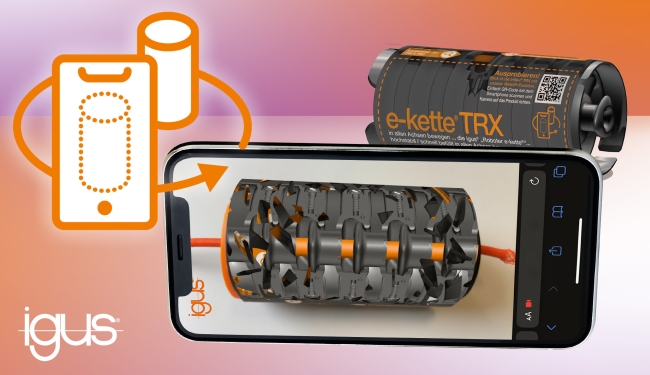3 minute read • published in partnership with igus
Feature: igus meets the metaverse as plastics specialist brings engineering and sales into virtual reality
Closely inspect products from all sides wearing virtual reality (VR) glasses. Plan machines, systems and vehicle assemblies together with engineers and material experts in VR, quickly and independently of your location. igus has created a digital parallel universe that prepares sales and engineering professionals for the metaverse – the new iguverse.
The online game Fortnite shows how powerful a digital parallel universe can become – a computer game that allows people to participate in social events in a 3D simulation. 12.3 million players gathered in virtual space in April 2020 when rapper Travis Scott gave a digital concert with an avatar. A digital parallel universe could become similarly important for industry and business. “We are pursuing the vision of “iguverse”, a virtual space in which all our products can be experienced as digital twins,” says igus UK managing director Matthew Aldridge. “In the future, customers from all over the world will have the opportunity in iguverse to develop machines, systems and machines together with igus, partner engineers and project managers and to immerse themselves in the projects and applications – saving time and money.”

Picture: igus
Customers are up to nine times more likely to remember what they experience in “reality”
Visitors to the IAA Transportation 2022 trade show in Hanover were given a taste of this future vision. At the igus stand, visitors were able to put on VR glasses and, together with employees, take a first look at the beginnings of the igus metaverse. In the future, they will be able to see 3D models of products such as energy chains in a 360-degree panoramic view from all sides. People will experience the infrastructure of igus, like the 3,800m2 test laboratory in Cologne or immerse themselves in multiple applications where igus components are used. These range from a plastic bicycle to a futuristic mini-van with iglidur plain bearings, drylin linear guides and e-chains for an oil platform, where the modular energy chain system e-loop is used. These give impressions that cannot be conveyed so impressively, nor with such lifelike realism using classic media such as catalogues, brochures and multimedia presentations, or even videos or 3D renderings.
“With iguverse, we are embarking on a new path of presentation, selling and engineering,” emphasizes Aldridge. For many, the metaverse is new territory. igus also wants to learn something new and to explore this path with our customers, a path with a lot of potential for business development. For example, sales representatives and customers could put VR glasses on during customer visits and immerse themselves in the iguverse. “Studies show that customers are up to nine times more likely to remember experiences they receive in daily reality and therefore understand them more quickly,” says Aldridge.

Picture: igus
Time-saving and low-friction engineering in virtual reality
Digital twins of products and igus’s facilities are only one expansion stage of iguverse. In the future, customers, engineers, and material experts will come together as avatars in a digital space and carry out entire engineering projects, faster and with less friction than is possible in the physical world.
In a further stage, igus is also considering expanding the iguverse with a B2B platform for other manufacturers. The companies can then present machines and systems in this virtual space, using igus components. According to US market research company Gartner, by 2025, digital channels will account for 80% of B2B sales interactions between suppliers and buyers. To support this, igus will create a growing reference database for all motion plastics with its own B2B platform, which will be accessed virtually.
Sell digitally with augmented reality
In a further development, igus will rely more on a new form of digital selling and presentation using augmented reality (AR).
An example of this is the energy chain of the triflex TRX series. In the past, sales personnel and customers hardly had a chance to look at the detail inside a closed chain. Some mechanical principles, which are particularly relevant in the triflex TRX, were left to the imagination. Here, an AR application assists buyers and engineers. When the employee activates the software on their smartphone via a QR code on the e-chain, the application overlays the product on a screen with an animated virtual twin. This allows a kind of X-ray view of the mechanics inside of the chain. This immediately brings the product to life and helps the design selection process.
